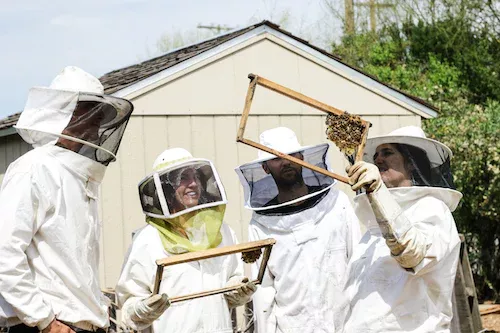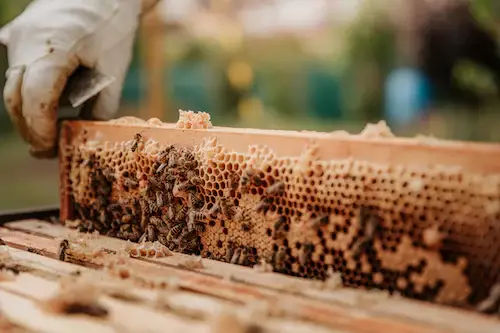8 Common Types of Beekeeping: Pros & Cons Of Each
Beekeeping is a rewarding and enjoyable hobby that can provide you with a unique perspective on the natural world. This guide will help you understand the different types of beekeeping and the advantages and disadvantages of each.
There are common types of beekeeping, including Langstroth, Warre, and Flow Hive methods. They are modular, allowing beekeepers to easily expand their hives or move them, but it requires more maintenance than other types of hives; the frames are heavier and more expensive, and more susceptible to wax moths.
Find out what types of beekeeping are traditional, low-cost, and low-maintenance, and decide which type may be best for you.
Summary
- There are natural beekeeping methods, including Top Bar and Horizontal Beekeeping that are low-cost and low-maintenance.
- Natural and Bee Tree beekeeping methods are traditional methods to sustain bees.
- Warre and Langstroth's methods of beekeeping require building boxes for the bees.

On this page:
Common Types of Beekeeping and Their Pros and Cons
Bees are valuable pollinators and important for the environment. Beekeeping, the practice of keeping honey bees, can provide many benefits. Here are 10 common types of beekeeping and their pros and cons. Learn which type is best for you and your goals.
1. Top Bar Beekeeping
Top bar beekeeping is an increasingly popular method of beekeeping. It is a low-intervention, natural beekeeping method that is becoming more popular among beekeepers.
Pros of top bar beekeeping
- Top bar beekeeping is one of the least expensive forms of beekeeping. It requires fewer tools and equipment, and it can be done with minimal investment.
- It is a natural form of beekeeping. It is less intrusive on the bees and encourages natural behaviors.
- It is easy to maintain. It requires less maintenance than traditional beekeeping methods.
Cons of top bar beekeeping
- Top bar hives produce less honey than traditional hives. This is because the bees are not as efficient in their honey production.
- It does not allow for easy monitoring of the hive. It is difficult to check for diseases, pests, and other issues.
- It is not widely accepted as an effective method of beekeeping. Many beekeepers prefer traditional methods as they are proven to be more effective.
- It requires more maintenance than traditional beekeeping. The bees must be constantly monitored, and the hives must be maintained regularly.
- It is more expensive than traditional hives. The cost of equipment and supplies can be higher, making it a more expensive hobby.
2. Warre Beekeeping
Warre beekeeping, also known as vertical top bar beekeeping, is a style of beekeeping that is becoming increasingly popular among hobbyists and professional beekeepers. In Warre beekeeping, bees build their comb in managed wooden boxes.
Pros of Warre beekeeping
- Warre beekeeping is a more natural form of beekeeping that emulates the way bees naturally build and live in their hives.
- It is more sustainable, as it requires fewer inputs such as sugar water, wax, or plastic frames.
- It does not require the use of bee smokers, as the bees are much less likely to become agitated and defensive.
Cons of Warre beekeeping
- Warre beekeeping is more labor-intensive since the boxes need to be checked more frequently for signs of swarming.
- It is more expensive since the boxes are larger and more difficult to build.
- It is prone to wax moths since the boxes are not as well constructed.
3. Langstroth Beekeeping
This method of beekeeping uses movable frames and boxes that allow the beekeeper to inspect and manipulate the hive without destroying it. Langstroth beekeeping has become the most widely used form of beekeeping throughout the world.
Pros of Langstroth beekeeping
- Langstroth beekeeping allows the beekeeper to inspect the hive without damaging it, which makes it easier to monitor the health of the bees.
- The movable frames used in Langstroth beekeeping make it easier for bees to store and access honey, which increases the amount of honey produced.
- The movable frames make it easier to spot and remove pests from the hive, which helps keep the bees healthy.
Cons of Langstroth beekeeping
- The movable frames and boxes used in Langstroth beekeeping can be expensive, which may make them out of reach for some beekeepers.
- The frames and boxes must be regularly inspected and maintained, which can be a time-consuming process.
- It is not ideal for all bee species and may not be suitable for some types of hives.
4. Kenya Top Bar Beekeeping
Kenya Top Bar Beekeeping is a form of beekeeping that is becoming increasingly popular in many parts of the world, especially in Africa. It is a method of beekeeping that uses a horizontal bar hive with multiple bars, or "combs," that are placed at the top of the hive.
Pros of Kenya top bar beekeeping
- Kenya Top Bar Beekeeping is much more natural for bees, as the hive mimics a natural tree cavity.
- The bees are more likely to stay in the hive, making it easier to manage.
- It allows for observation of the bees without having to open the hive, making it safer for the beekeeper.
Cons of Kenya top bar beekeeping
- It involves a more labor-intensive process than other forms of beekeeping, as each bar needs to be inspected and managed regularly.
- It can be difficult to harvest honey from this type of hive as it involves manually cutting out the comb.
- It can be difficult to get the temperature and humidity of the hive regulated.

5. Flow Hive Beekeeping
Flow Hive is a revolutionary beekeeping system that allows beekeepers to harvest honey without disturbing the bees. It uses patented Flow frames and a built-in tap to allow the honey to flow from the hive directly into jars.
Pros of flow hive beekeeping
- Flow Hive beekeeping requires minimal maintenance and can be easily managed from a distance.
- It is less intrusive than traditional beekeeping methods and allows the bees to live in their natural environment.
- It is a sustainable and environmentally friendly way to harvest honey without harming bees or their hives.
Cons of flow hive beekeeping
- Flow Hive beekeeping is more expensive than traditional beekeeping methods.
- It can only produce a limited amount of honey at a time.
- It is unpredictable and can be affected by environmental factors such as weather and predators.
6. Horizontal Top Bar Beekeeping
Horizontal Top Bar Beekeeping is a natural beekeeping method that utilizes a horizontal hive structure rather than the traditional vertical style. This method relies on the natural behavior of bees to build their combs and does not require the use of standard frames or foundations.
Pros of horizontal top bar beekeeping
- Easier to manage and inspect since the combs are easily accessible.
- Low cost since the horizontal top bar hive does not require frames or foundation.
- Low maintenance since the bees build the combs on their own.
Cons of horizontal top bar beekeeping
- Bees may not consistently build combs, resulting in non-uniform honey production.
- Difficult to harvest honey since the combs are not arranged in a standard pattern.
- May require more frequent inspections since the hive is open-style and not sealed.
7. Natural Beekeeping
Natural Beekeeping is an alternative form of beekeeping that is focused on the well-being of the bees and the environment. Natural Beekeepers aim to keep their hives as natural as possible, avoiding the use of chemicals and other treatments. This form of beekeeping is gaining popularity as more people become aware of its benefits.
Pros of natural beekeeping
- Natural Beekeepers rely more on natural treatments to keep their bees healthy, reducing the number of chemicals used in the hive.
- It is focused on providing the bees with a healthy environment, which helps to keep them healthy.
- It often uses more natural methods of increasing honey production, such as providing the bees with a variety of flowers or herbs to feed on.
Cons of natural beekeeping
- Natural Beekeepers rely more on natural treatments, which can increase the risk of disease due to the lack of chemical treatments.
- It requires more time and effort, as it requires the beekeeper to monitor the hive more carefully and to take additional steps to ensure the health of the bees.

8. Bee Tree Beekeeping
This method is based on traditional beekeeping principles, but with modern advances in technology and materials, it allows for a more efficient and sustainable way to keep bees.
Pros of bee tree beekeeping
- Bee Tree Beekeeping requires minimal equipment and tools to get started, making it an affordable way to get into beekeeping.
- It is a more sustainable way to keep bees since it does not require large amounts of resources or chemicals.
- It is a great way to help the environment by reducing the number of pesticides and other chemicals used in beekeeping.
Cons of bee tree beekeeping
- Bee Tree Beekeeping requires more time and effort than other methods of beekeeping, so it may not be suitable for those with limited time or resources.
- It requires more frequent visits to the apiary, so it can be difficult to maintain a large stock of bees.

